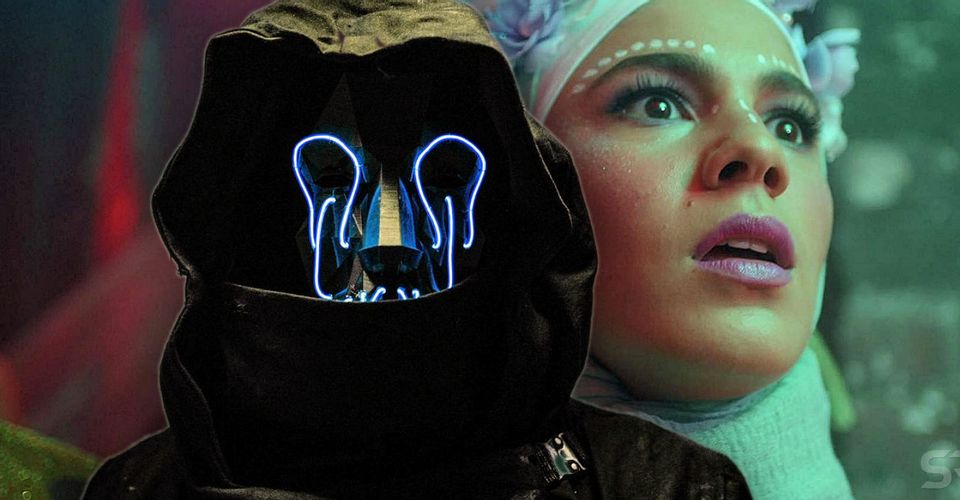Slasher Season 3 Ending & Killer’s Identity Explained

The ending of Netflix’s Slasher season 3 explores the consequences of the Bystander Effect. In the new installment “Solstice,” a series of murders terrify the residents of an apartment complex, as the crimes are seemingly connected to an unsolved murder from one year prior. Slasher season 3 appears to be partially based on the 1964 murder of Kitty Genovese, in which numerous witnesses failed to react appropriately or lend assistance during a New York City attack. The conclusion of Slasher season 3 incorporates the Bystander Effect, along with a sociopolitical commentary on the dangers of social media.
Slasher season 3 features a killer known as The Druid, who is revealed to be three separate people. The opening moments show the murder of Kit Jennings, a bisexual sex addict. Through flashback sequences, it’s revealed that his neighbor, Justine Rijkers, posted a judgmental message about Kit’s lifestyle on social media. After receiving death threats, Justine publicly commits suicide by lighting herself on fire. Meanwhile, nobody attempts to help while the woman’s terrified children watch. Slasher season 3 reveals that Kit’s murder was a stand-alone event. The subsequent copycat killings, one year later, were committed by Justine’s children, Connor and Jen. As a whole, Slasher season 3 uses race, gender, and social media etiquette to re-direct character blame while framing a young girl named Saadia as innocent and pure. The irony is that the entire community is collectively guilty of judgmental behavior.
The primary villains in Slasher season 3 are Connor and Jen. They kill out of vengeance and rage; their murders are calculated and vicious. Early on, however, Connor and Jen are presented as sympathetic figures. Their mother Justine, a black lesbian, is publicly humiliated, and they watch in horror as she burns herself to death. This is Slasher season 3’s true inciting incident – not the murder of Kit. The entirety of Slasher season 3 underlines the trials and tribulations of various apartment residents, all the while hiding the fact that Connor and Jen are deeply resentful. They behead the mob-connected Frank Dixon because he’s judgmental and beats his wife. They murder the blogger Violet Lickers for using their mother’s death to gain followers and make money. The murders are staged as blatant messages for the community: a teacher is dissected; a beautiful yet promiscuous teenager is dunked in acid. The recurring theme is #YouReapWhatYouSow. On the surface, the slasher killings fulfill the horror premise. On a deeper, level, however, Slasher season 3 is about memory, misunderstandings, and owning up to one’s actions.

Kit’s death represents a red herring in Slasher season 3. It pushes the story forward, but it’s not the work of one serial killer known as The Druid. A jealous man named Wyatt murders Kit for sleeping with his girlfriend, Noelle, who he later kills as well. That particular subplot sustains the suspense and connects Wyatt’s arc to celebrity culture. He could theoretically become famous in jail as The Druid, but he’s reminded by detectives that ego could ultimately be his downfall. In 2019 alone, this concept has been explored by Netflix with The Bundy Tapes and Extremely Wicked, Shockingly Evil and Vile. Most recently, Ava DuVernay explored the phenomenon of false admissions with the Netflix miniseries When They See Us.
In Slasher season 3, the real Druid killers – Connor and Jen – want anonymity and moral justice. Their step-mother suffers a mental breakdown, and she pushes the teenagers to seek revenge. Through social media culture, along with the diversity of the buildings’ residents, Connor and Jen are consistently reminded that nobody actually cares about what happened to their mother. Ironically, their behavior brings together a local racist, Dan, and a gay man, Angel. These men work together and connect while being trapped in the building’s death dungeon. This Slasher season 3 subplot feels forced, as all traces of Dan’s racism mostly disappear, but his character arc does indeed hammer home the underlying themes of acceptance and change. The killers’ are motivated by revenge, but the series’ connective tissue is focused on race, gender, and how one comes to terms with dark societal truths.
The true protagonist in Slasher season 3 is a Muslim teenager named Saadia. She’s befriended by Jen and becomes Connor’s love interest, all the while being framed as a morally pure character. Saadia recalls a dark past in Afghanistan, and those memories allow her to identify the building’s strange smell in the season finale. But Slasher season 3 reveals that Saadia was the first social media commenter on Justine’s judgmental post about Kit. This final Slasher reveal isn’t necessarily a shocking or impactful twist, but it does remind audiences that social media can easily skew perspectives, especially in a politically divided culture.
About The Author


















